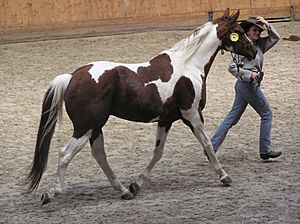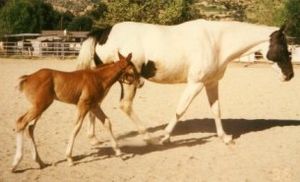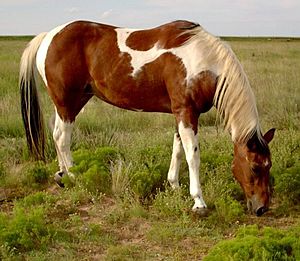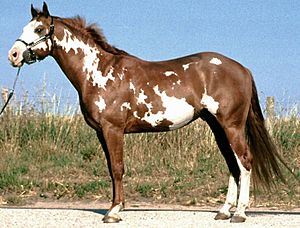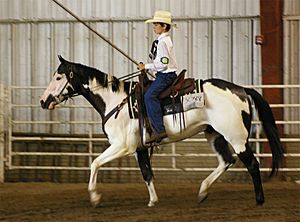American Paint Horse facts for kids
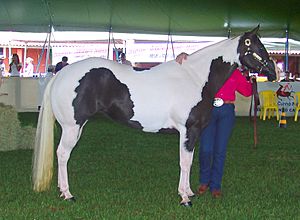
American Paint Horse
|
|
| Distinguishing features | Broad pinto spotting patterns of white and dark hair |
|---|---|
| Alternative names | Paint |
| Country of origin | United States |
| Common nicknames | Paint |
| Breed standards | |
| American Paint Horse Association | Breed standards |
| Horse (Equus ferus caballus) | |
The American Paint Horse is a special type of horse. It has the strong body of a western stock horse. It also has a unique pinto coat pattern. This means it has patches of white and dark colors.
These horses were developed from spotted horses. They have bloodlines from Quarter Horses and Thoroughbreds. The American Paint Horse Association (APHA) is one of the biggest horse registries in North America. This group registers horses. They even register some horses without spots. These are called "Solid Paint Bred." The APHA sees the American Paint Horse as a true horse breed. It's not just a color breed.
Contents
Getting Your Paint Horse Registered
The American Paint Horse is popular for its color and body shape. This has made the American Paint Horse Association (APHA) very large. It's the second-biggest horse registry in the United States. The colorful coat is a big part of the breed's look. But Paint Horses also need specific family lines. They must also have a certain stock-horse body type.
To be registered, a Paint horse's parents must be registered. They can be registered with the APHA, the American Quarter Horse Association, or the Jockey Club (Thoroughbreds). At least one parent must be a registered American Paint Horse. There are two main ways to register a Paint. One is for horses with spots (regular). The other is for horses without spots (solid Paint-bred).
Regular APHA Registration
For a horse to be in the APHA Regular Registry, it needs more than just the right parents. It must also have a "natural paint marking." This means it needs a main coat color with at least one white spot. This white spot must be a certain size. It must also have uncolored skin underneath.
If the horse is mostly white, it needs a colored spot. This spot must also be a certain size. It needs colored skin underneath. These natural markings usually need to be bigger than two inches. They must also be in certain areas on the horse's body.
Solid Paint-Bred Horses
Sometimes, two registered Paint parents have a solid-colored foal. These are called "Solid Paint-Breds." They can also be registered, but with some rules. They can take part in some Paint breed shows. There are also special programs for them. Many reward programs within the APHA are open to Solid Paint-bred horses.
If a solid-colored horse is bred with a regular Paint horse, they can have a spotted foal. Some solid-colored horses can still carry genes for color. This is true for some sabino patterns. However, a Solid Paint-Bred horse with the dominant tobiano pattern will not carry those color genes. But they can still pass on other good traits.
Paint Horse Colors
Every Paint Horse has a mix of white and another color. The most common colors are black, bay, brown, and chestnut or sorrel.
Some Paints have less common colors. These colors are changed by special genes. Examples include palomino, buckskin, cremello, and perlino. They can also be shades of roan or dun. Paints can also have the gray gene. This means their spots might fade to white over time. But the skin underneath will stay colored.
Paint spots can be any shape or size. They can be almost anywhere on the horse's body. However, they don't have the leopard complex pattern. That pattern is special to the Appaloosa breed. Paint Horses have four main coat patterns: overo, tobiano, tovero, and solid.
Solid Paint-Bred horses might show small color traits. This is especially true if they carry sabino genes. These traits can include blue eyes or pink skin on their lips. They might also have small roan spots.
Understanding Color Patterns
- Tobiano: This is the most common pattern. It has rounded markings. The legs are white, and white crosses the back. This white is usually in a vertical pattern. There is often more white than dark color. The head is usually dark. It might have normal horse markings like a star or blaze.
- Overo: This group has sharp, uneven markings. They are usually more horizontal. There is often more dark color than white. The face is usually white, sometimes with blue eyes. The white rarely crosses the back. The lower legs are usually dark. The APHA recognizes three overo patterns:
- Frame: This is a well-known overo pattern. The gene for frame has been studied. If a horse gets two copies of this gene, it leads to Lethal White Syndrome (LWS). Horses with one copy of the gene look normal and are healthy. They have jagged white patches on their sides. This leaves a "frame" of color around the white. This frame usually includes the topline.
- Sabino: This pattern can look like roan. It has high white on the legs and belly spots. White markings on the face can go past the eyes. There can also be patches of roaning.
- Splashed white: This is the least common pattern. These horses often have blue eyes. They have crisp, smooth white markings. These markings almost always include the head and legs. The tail is often white. Body markings start under the belly and spread upwards.
- Tovero: This pattern is a mix of tobiano and overo colors. An example is blue eyes on a dark head.
- Solid: This is a horse that can be registered as a Paint. But it does not have any white spots that make up a recognized pattern.
- "Color": This is an informal term. It means the horse has a spotting pattern. It's the opposite of "Solid."
- "Chrome": This is an informal term. It's used to describe a very flashy or striking spotting pattern.
- Pintaloosa: This is an informal term. It describes a horse that is a mix of an American Paint and an Appaloosa.
Paint or Pinto?
People sometimes use "Paint" and "Pinto" to describe these horses. But "Paint" refers to the specific breed of horse. "Pinto" actually refers to the coloring of the horse.
History of the Paint Horse
The American Paint Horse shares its family tree with the American Quarter Horse and the Thoroughbred. A registered Paint horse should look like a "stock horse." This means it's a muscular animal. It's strong but not too tall. It has a low center of gravity for easy movement. Its strong back legs are good for fast starts and sprints.
In 1940, the American Quarter Horse Association was formed. They wanted to protect horses of the "stock" type. But they did not include horses with pinto coat patterns. They also excluded "crop out" horses. These were born with white body spots or white above their knees.
But fans of colorful stock horses didn't give up. They created different groups to save and promote Paint horses. In 1965, some of these groups joined together. This formed the American Paint Horse Association.
What Paint Horses Do
Paint Horses are used in many horse riding activities. They are most common in Western pleasure, reining, and other Western events. But they are also ridden English. They compete in hunt seat or show jumping too.
Genetic Health Concerns
One health issue linked to the breed is lethal white syndrome (LWS). This is also called Overo lethal white syndrome (OLWS). It is connected to a gene linked to the frame overo pattern. Horses that carry one copy of this gene do not get the condition. They are healthy.
However, if a foal gets two copies of the LWS gene, it will be very sick. It will need to be humanely put to sleep soon after birth. Or it will die within a few days. This is because its intestines don't develop properly. A DNA test is available for LWS. This helps breeders avoid breeding two horses that carry the gene. This way, they can prevent foals with LWS.
Horses can carry the LWS gene without showing overo coloring. Cases have appeared in foals from both tobiano and solid-colored parents. But all these horses had overo ancestors. LWS is not only found in Paint Horses. It can happen in any horse breed that has the frame overo coat pattern.
Because of a lot of American Quarter Horse breeding, some Paints might also carry other genetic problems. These include hyperkalemic paralysis (HYPP) and hereditary equine regional dermal asthenia (HERDA). They can also have equine polysaccharide storage myopathy (PSSM) and malignant hyperthermia (MH). Another is glycogen branching enzyme deficiency (GBED). Some bloodlines with Thoroughbred ancestry might have a higher risk for Wobbler's syndrome.
See also
 In Spanish: Paint horse para niños
In Spanish: Paint horse para niños


